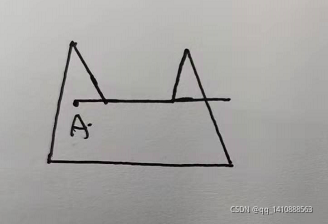1、概述
判断一个点是否在多边形内有几种不同的思路,相应的方法有很多:
- 射线法:从判断点向某个统一方向作射线,依交点个数的奇偶判断;
- 转角法:按照多边形顶点逆时针顺序,根据顶点和判断点连线的方向正负(设定角度逆时针为正)求和判断;
- 夹角和法:求判断点与所有边的夹角和,等于360度则在多边形内部。
- 面积和法:求判断点与多边形边组成的三角形面积和,等于多边形面积则点在多边形内部
因此,本文是通过射线法来进行判断点是否在多边形内的,主要用于无人机判断有没有进入准飞行区和禁飞区。
2、射线法的实现
射线法就是以判断点开始,向右(或向左)的水平方向作一射线,计算该射线与多边形每条边的交点个数,如果交点个数为奇数,则点位于多边形内,偶数则在多边形外。

网上大部分的射线法都是以向右或者向左作一射线的方法,但是都存在一个没有考虑的情况(类似下图,如何判断点所作的射线与多边形一条边界重合了,该怎么判断):

为此,在使用C++编写代码时,对于射线的方向进行了改进,不再采用单一的射线方向,而是给它一个数组的形式来存放不同斜率的射线方向。
整体代码如下:(可直接运行)
1 #include <iostream> 2 #include <string> 3 #include <cmath> 4 5 #define PI 3.1415926 6 #define EXP 1e-6 // 精度 7 8 9 10 int main() { 11 /* start_point表示判断点,point_all代表多边形点的二维数组 */ 12 double start_point[] = { 0.0, 0.0 }; 13 14 double point_all[5][2] = { 15 { 0.0, -1.0 }, 16 { -2.0, 1.0 }, 17 { 2.0, 2.0 }, 18 { 1.0, 1.0}, 19 { 1.0, 0.0 } 20 }; 21 22 const int n = 5;// +1; 23 const int double_n = 2 * n; 24 double All_point_xy[double_n + 2] = {}; 25 26 for (int i = 0; i < n; i++) { 27 for (int j = 0; j < 2; j++) { 28 All_point_xy[2 * i + j] = { point_all[i][j] }; // 想将接收的多边形点放到一个一维数组中 29 } 30 } 31 32 All_point_xy[double_n] = All_point_xy[0]; 33 All_point_xy[double_n + 1] = All_point_xy[1]; // 为方便多边形边界判断,再次将开头点放到末尾 34 35 printf("点元素集合(末尾重复开头):\n"); // 验证 36 for (int i = 0; i < double_n + 2; i++) { 37 printf("%f , ", All_point_xy[i]); 38 } 39 40 41 int counter = 0; 42 double point_x; // 交点x坐标 43 double point_y; // 交点y坐标 44 double theta = 45; 45 double theta_arr[11] = { 45, 60, 256, 128, 64, 32, 16, 8, 4, 2, 1 }; // 不同角度的射线方向 ,选择45,60进行验证,使用的时候可以直接使用{256, 128,64, 32, 16, 8, 4, 2, 1} 46 double t, b; 47 double Deg2rad = 180 / PI; // C++ 中三角函数计算,运用的是弧度 48 double tan_theta = tan(theta / Deg2rad); // 转换至弧度,进行正切值计算 49 printf("\n验证正切值:%lf", tan_theta); // 验证转换关系,以及求解是否正确 50 51 bool Coincidence_judgment = false; // 重合判段标识 52 bool Coincidence_judgment02 = false; // 为更好地跳出循环,进行了两次重合判断 53 for (int i = 0; i < (std::end(theta_arr) - std::begin(theta_arr)); i++) { // 获得数组的长度方法 54 int now_theta = theta_arr[i]; 55 56 for (int j = 0; j <= (n - 1); j++) { 57 double point_start_x = All_point_xy[2 * j]; 58 double point_start_y = All_point_xy[2 * j + 1]; 59 double point_end_x = All_point_xy[2 * j + 2]; 60 double point_end_y = All_point_xy[2 * j + 3]; 61 double slope_half_line = tan( theta_arr[i] / Deg2rad ); // 射线斜率 62 double slope_line_segment = (point_end_y - point_start_y) / (point_end_x - point_start_x); // 两点形成直线的斜率 63 double err_0 = abs(slope_half_line - slope_line_segment); // 由于无法绝对相等,设计了精度差 64 65 printf("\n%d", j); 66 if ( err_0 < EXP ) { // 斜率相等,表示射线与边界平行或重合,再次求解两点与判断点之间的斜率,如果两个相等,则表示重合 67 double slope2start = (point_start_y - start_point[1]) / (point_start_x - start_point[0]); 68 double slope2end = (point_end_y - start_point[1]) / (point_end_x - start_point[0]); 69 double err_1 = abs(slope2end - slope2start); 70 if ( err_1 < EXP ) { 71 Coincidence_judgment = true; // 重合 72 Coincidence_judgment02 = true; 73 } 74 } 75 if ( Coincidence_judgment == true ) { 76 Coincidence_judgment = false; 77 break; // 重合则表示该斜率不可用,跳出整个循环 78 } 79 // 如果不重合,则利用两个直线求交点的公式求解交点坐标 80 b = start_point[1] - slope_half_line * start_point[0]; 81 t = (slope_half_line * point_start_x + b - point_start_y) / (point_end_y - point_start_y - slope_half_line * (point_end_x - point_start_x)); 82 point_x = (point_end_x - point_start_x) * t + point_start_x; 83 point_y = (point_end_y - point_start_y) * t + point_start_y; 84 85 printf("\n%d", now_theta); 86 printf("\n求解交点坐标:%lf, %lf ", point_x, point_y); 87 88 // 判断交点是否在两点形成的线段上,如果不在,就跳过不需计数 89 if ((point_x > point_start_x) && (point_x > point_end_x)) { 90 printf("x坐标上限均大于两端点,故舍弃并跳出\n "); 91 continue; 92 } 93 else if ((point_x < point_start_x) && (point_x < point_end_x)) { 94 printf("x坐标上限均小于两端点,故舍弃并跳出\n "); 95 continue; 96 } 97 else if ((point_y > point_start_y) && (point_y > point_end_y)) { 98 printf("y坐标上限均大于两端点,故舍弃并跳出\n "); 99 continue; 100 } 101 else if ((point_y < point_start_y) && (point_y < point_end_y)) { 102 printf("y坐标上限均小于两端点,故舍弃并跳出\n "); 103 continue; 104 } 105 else { 106 printf("正常值,触发 counter++;\n "); 107 108 if (start_point[0] > point_x) { // 由于上面求解交点坐标方式是以直线形式进行的,将其转换至一个方向表示射线形式 109 counter++; 110 } 111 112 } 113 114 } 115 if (Coincidence_judgment02 == true) { 116 Coincidence_judgment02 = false; 117 counter = 0; 118 continue; 119 } 120 else { 121 break; 122 } 123 124 } 125 126 printf("\n交点个数 = %d", counter); 127 128 if (counter % 2 == 1) { 129 printf("\n点在多边形的内部"); 130 } 131 else { 132 printf("\n点在多边形的外部"); 133 } 134 return 0; 135 }
3、补充知识点
C++实现求两条直线的交点
C++实现求两条直线的交点,以及已知直线外一点求垂足_c++求两直线交点_只道寻常zero的博客-CSDN博客